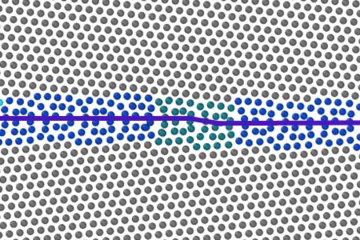All genres
201.
Journal Article
Electronic hybridisation implications for the damage-tolerance of thin film metallic glasses. Scientific Reports 6, 36556 , pp. 1 - 12 (2016)
202.
Journal Article
Transition from shear to stress-assisted diffusion of copper–chromium nanolayered thin films at elevated temperatures. Acta Materialia 100, pp. 73 - 80 (2015)
203.
Journal Article
Nanotribology in austenite: Plastic plowing and crack formation. WEAR 338–339, pp. 436 - 440 (2015)
204.
Journal Article
Nanotribology in austenite: Normal force dependence. WEAR 338–339, pp. 430 - 435 (2015)
205.
Journal Article
Influence of inclined twin boundaries on the deformation behavior of Cu micropillars. Materials Science and Engineering A: Structural Materials Properties Microstructure and Processing 642, pp. 65 - 70 (2015)
206.
Journal Article
In situ TEM microcompression of single and bicrystalline samples: insights and limitations. JOM-Journal of the Minerals Metals & Materials Society 67 (8), pp. 1704 - 1712 (2015)
207.
Journal Article
Comparing small scale plasticity of copper-chromium nanolayered and alloyed thin films at elevated temperatures. Acta Materialia 93, 12073, pp. 175 - 186 (2015)
208.
Journal Article
Adhesion measurement of a buried Cr interlayer on polyimide. Philosophical Magazine 95 (16-18), pp. 1982 - 1991 (2015)
209.
Journal Article
The peculiarity of the metal-ceramic interface. Scientific Reports 5, 11460 (2015)
210.
Journal Article
Micro-tension study of miniaturized Cu lines at variable temperatures. Acta Materialia 92, pp. 243 - 254 (2015)
211.
Journal Article
Formation of dislocation networks in a coherent Cu Σ3 (1 1 1) twin boundary. Scripta Materialia 102, pp. 71 - 74 (2015)
212.
Journal Article
Mechanical and chemical investigation of the interface between tungsten-based metallizations and annealed borophosphosilicate glass. Thin Solid Films 583, pp. 170 - 176 (2015)
213.
Journal Article
Downscaling metal-dielectric interface fracture experiments to sub-micron dimensions: A feasibility study using TEM. Surface and Coatings Technology 270, pp. 1 - 7 (2015)
214.
Journal Article
The influence of a brittle Cr interlayer on the deformation behavior of thin Cu films on flexible substrates: Experiment and model. Acta Materialia 89, pp. 278 - 289 (2015)
215.
Journal Article
Internal and external stresses: in situ TEM compression of Cu bicrystals containing a twin boundary. Scripta Materialia 100, pp. 94 - 97 (2015)
216.
Journal Article
Importance of dislocations pile-ups on the mechanical properties and the Bauschinger effect in micro cantilevers. Journal of Materials Research 30 (6), pp. 791 - 797 (2015)
217.
Journal Article
Can micro-scale fracture tests provide reliable fracture toughness values? A case study in silicon. Journal of Materials Research 30 (5), pp. 686 - 698 (2015)
218.
Journal Article
Nanostructure and mechanical behavior of metastable Cu–Cr thin films grown by molecular beam epitaxy. Acta Materialia 83, pp. 318 - 332 (2015)
219.
Journal Article
Influence of initial microstructure on thermomechanical fatigue behavior of Cu films on substrates. Microelectronic Engineering 137, pp. 5 - 10 (2015)
220.
Journal Article
Interface fracture and chemistry of a tungsten-based metallization on borophosphosilicate glass. Philosophical Magazine 95 (16-18), pp. 1967 - 1981 (2015)










